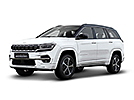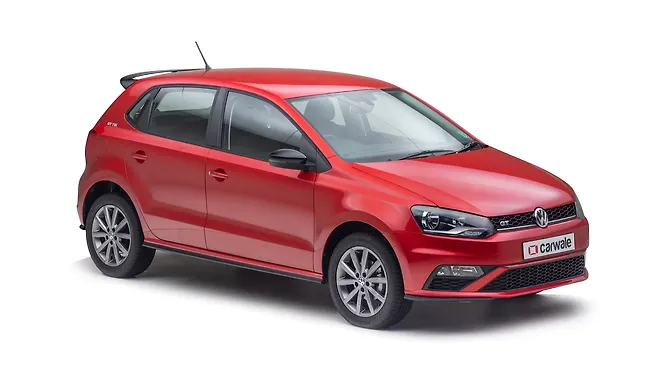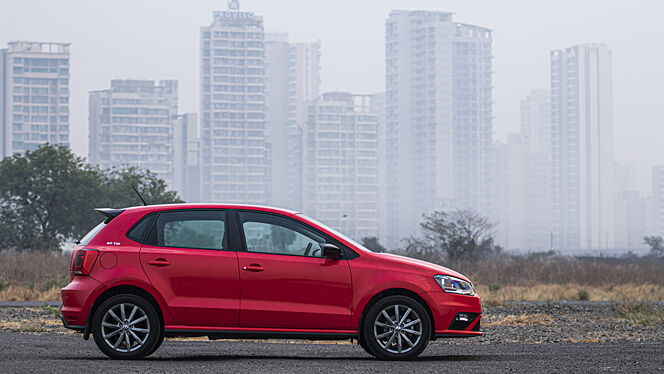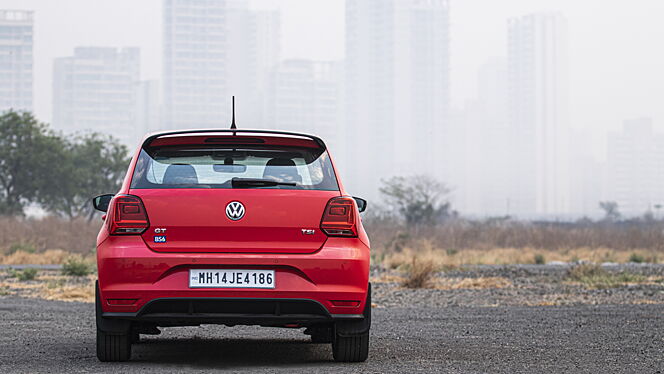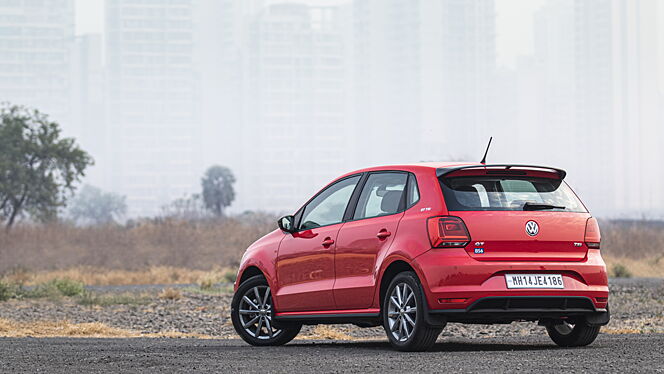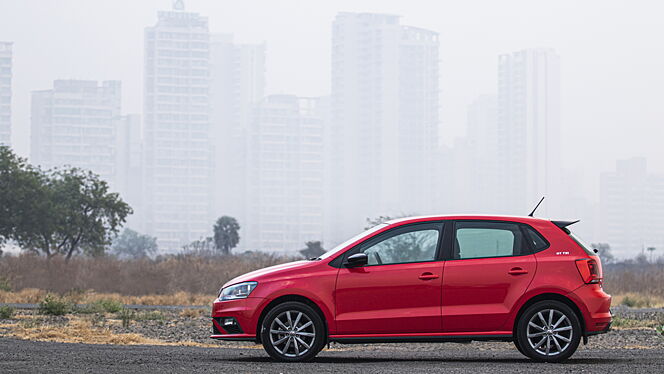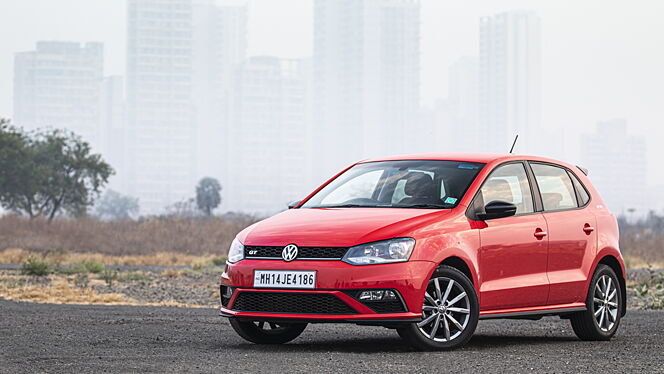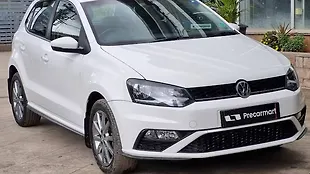Volkswagen Polo GT
Variant
Volkswagen Polo GT Summary
Volkswagen Polo GT Review
Engine and Performance
8

New normal means we all walk out only with a face mask on and all Volkswagens in India are only powered by a TSI motor. No more diesel, so no GT TDI anymore. Meanwhile, the 1.2-litre motor of the previous GT TSI has made way for the BS6-compliant 1.0-litre TSI with three cylinders and a turbocharger. Power output is rated at 109bhp available at 5,000rpm and a twisting force of 175Nm accessible from 1,750rpm. You can only opt for the GT with a six-speed automatic, and no, this isn’t the butter-smooth and lightning-quick DSG. In the new normal, there’s only a torque-converter available in the Polo range.

Trust the Germans to do something new and they’d do it the best way possible still. This applies to the new range of 1.0-litre three-cylinder turbocharged range of engine which we have seen an outset of lately. The 999cc TSI can easily be regarded as a benchmark when it comes to the one-litre turbo-petrol class. Crank it up and while idling, it is refined and silent with no vibrations you’d generally associate with a three-pot motor. Pull the lever to D – which again has that typical German finesse – and let go off the brake pedal and there’s a lurch from the eager motor. It’s not as good at creeping as an AMT and you’d immediately need to get on the gas to get any momentum off the line – especially when rolling off the mark at a traffic light. That’s not all, get on the gas just a tad harder and the lurching ahead is even pronounced. So you’d need to master this art all over again.

On the move, the motor is eager. It’s easy to get carried away at times as the Polo GT TSI has a certain enchantment that brings out the bad boy in you. With a free-revving engine that’s quick to throttle response and a good surge of power, it all comes together to assert what that GT badge manifests. At city speeds, you’d be doing slightly higher speeds than you’d realise, and out on the highway triple-digit speeds come quickly and effortlessly. There’s no harsh vibration from the motor even when wrung hard all the way to the redline, only the soundtrack getting a bit whiny past 4,000rpm. Acceleration is quick, no matter where the tacho needle is sitting; just get on the gas and the power spread across the rev range hurls you ahead with little to no delay. All of this before the gear lever is pulled one more notch to the S.
Go for the S Mode and you’d notice there’s no artificial change in throttle response as is the trend these days with faux ‘sport modes’. In this mode, the motor just becomes aggressive in the way it delivers power. The tacho needle now doesn’t sway, just ticks – like one of those needles on an old multimeter. What’s more, it’s got the capability to pin you back into the seat when stomped on the accelerator. This mode would be great for quarter-mile times, but don’t go hunting for ‘traffic-light GPs’.

But it isn’t free of faults, of course. Replacing the legendary DSG with a torque converter was considered a bold move (blasphemy by the purists). And it shows. The shifts on the automatic are pronounced whether it’s going up the cogs or down. It’s almost like a jerk and makes you miss the prowess of the DSG furthermore. For first-timers or new buyers, it isn’t a dealbreaker at all. In fact, it supposedly brings down the price making it more enticing.
Ride and Handling
8

Ever since its introduction, the Polo has stood out of the ordinary with its ride and handling combination. This trait hasn’t been fiddled over the years and that’s a good thing – you can’t mend something that isn’t broken right? It’s got a comfortable ride at slow speeds yet you are always aware of what the tyres are plodding over. Surprisingly, even the sharp-edged potholes or those ill-made road joints are well absorbed without disturbing the passengers on the inside. When it comes to encountering speed breakers we were reluctant a bit at first – with its sharp lower lip upfront and extended side skirts. But not once we found it having small talks with the speed breaker no matter how nasty it was. Go up to highway speeds and the composure gets even better flattening out even the vilest irregularities or undulations you’d encounter.

One of the talking points of the Polo is how direct its handling is. There’s a certain precision in the way it changes direction. Sure at slow city speeds the heavy setup of the steering is enough to give you a good arms workout. And it doesn’t improve when speed increases. But who wants light steering when you are so connected and one with the car when behind the wheel. Helping its cause is the rigid chassis that Volkswagen is so proud of. So around tight corners, there’s controlled body movement inducing more confidence. Surprisingly though, there’s a very little intrusion from torque steer too when gassing it around a bend. And in a straight line, it’s as stable as a tree in a storm. Overall then, the Polo GT still is the best 'driver’s car’ by a huge margin.

Interior Space and Quality
6

Similar to the exterior, there aren’t any major changes to the Polo GT’s cabin since the first one rolled out when ISRO launched the Mangalyan in 2013. It’s all-black, minimalistic, function-over-form, and that’s about it. There are no gimmicky features or trinkets to take your mind off the most important thing – driving. You do get plaid-style seat covers now though. Even after almost a decade, the uncluttered layout is likable, and what makes it an even sweeter deal is its built quality. From the solid thud of the doors closing to the sturdiness of plastic used all around – everything inside the Polo has aged like a fine wine.

Some may argue that the old circular analogue dials need to go away in the age of digital driver’s display. But as mentioned above, the way the needle ticks is something the digital age meters will never match. Even the centre console, with its monochromatic screens and tactical switches and knobs, has its appeal. And the seats offer good support with the right amount of bolstering on the side but more under-thigh support would have been appreciated. There are no complaints in terms of visibility all around – even the interior rearview mirror is a perfect size cut out just enough to see the rear windscreen.

The Polo GT is meant to be driven, so the rear bench and its space isn’t something to write home about. There’s just enough head- and knee-room for an average-sized adult with just two being comfortable on the backbench. The presence of centre tunnel and the absence of rear AC vents makes sitting in the middle a tight affair. What’s more, even when no one’s sitting in the middle, the two passengers in the back aren’t provided with the luxury of an armrest, door pad space, back seat pocket, or a USB/12V point. Again, it’s a driver’s car, what are you even doing in the rear seats?

And if you are to carry stuff in the Polo GT, the boot space of 280litre is less in terms of volume, but it’s fairly square and usable. You could put down the rear seats for some additional space. But again it doesn’t fold flat and there’s no split-fold either.
Features and Safety
6

This top-spec Polo that you can buy in India has some comprehensive features list. It comes with auto air-con, one-touch control for all four windows, cruise control, rain-sensing wipers, rear parking sensor, dual-front airbags and ABS, and connectivity options in the form of Volkswagen Connect. There is touchscreen Apple CarPlay and Android Auto but there’s no navigation or voice control. There’s another long list - of features that are still missing in the Polo. This includes automatic headlamps, reverse parking camera, engine start button, LED lamps, sunroof, and a better sound system.
Conclusion

When going through the spec sheet, we realised that there’s nothing much that differentiates the Polo GT from the Polo Highline Plus Automatic trim – apart from spoiler and body kit, a couple of extra features, and the bellwether GT badge. And the GT is almost Rs 50,000 dearer. For the extra money, you get the bragging right of owning the best driver’s hatchback. Its new 1.0-litre TSI motor is a hoot to drive, even if the torque converter is not up to the mark, it’s still fun nonetheless. Everything else we loved or hated about the GT has been carried over. But all of it doesn’t matter when you are behind the wheel. And that’s all that matters, right?

Pictures by Kapil Angane
Polo GT Specifications & Features
- Specifications
- Features
- Specifications
- Features
Specifications
Engine & Transmission
- Engine999 cc, 3 Cylinders Inline, 4 Valves/Cylinder, DOHC
Timely services will keep a motor efficient and in top shape.
- Engine Type1.0L TSI
The official title given by the manufacturer in terms of the name of the engine, the displacement and the number of cylinders.
A bigger displacement and more than four-cylinders generally indicate a performance-oriented engine.
- Fuel TypePetrol
All cars in India either run on petrol, diesel, CNG, LPG or electric power.
- Max Power (bhp@rpm)109 bhp @ 5000 rpm
Gives a good idea of the performance of the vehicle under full thrust. A higher figure here usually means a higher top speed as well.
Higher the power, the peppier the engine but it can also affect fuel economy.
- Max Torque (Nm@rpm)175 Nm @ 1750 rpm
Relates to in-gear acceleration. A higher figure here means better roll-on acceleration, fewer gear shifts, and possibly better fuel efficiency.
The more torque at low RPM range makes the engine feel more responsive. It also allows the engine to run smoothly without too many gear changes.
- Mileage (ARAI)16.47 kmpl
This is the maximum fuel efficiency that an engine gives. All numbers are provided by the manufacturer based on tests conducted and specified by the standards of the ARAI (Automotive Research Association of India)
Such fuel efficiency attained while driving in special conditions makes it unlikely to get it in real-world conditions
- Driving Range820.8 km
Approximate maximum number of kilometers which can be traveled on a full tank of fuel or fully charged battery
- DrivetrainFWD
Cars come with different drivetrain configurations depending on the segment.
Front-wheel drive (FWD) is most common in mainstream cars while expensive cars or SUVs come with rear-wheel drive (RWD) or all-wheel drive (AWD).
- TransmissionAutomatic (TC) - 6 Gears, Manual Override
Type of transmission used to transfer power from the engine to the wheels
A manually operated transmission is the most popular type, thanks to its simplicity and low cost. Varied types of automatic transmissions are also available.
- Emission StandardBS 6
Set by the Indian Government, this governs the amount of air pollutants released by cars to make the atmosphere safer for humans.
- Turbocharger / SuperchargerTurbocharged
Manufacturers today offer turbochargers to boost engine power without affecting its fuel economy. Superchargers are found in more expensive cars but on the downside, they are not very efficient.
Turbochargers are more effective but require plenty of heat management. Superchargers, meanwhile, offer linear bump in power but they are comparatively more complex.
Dimensions & Weight
- Length3971 mm
The length of the car decides its segment. In India, cars that are less than 4 metres in length enjoy reduced excise duties.
- Length: 3971
Longer length results in more cabin space. It also adds to straight line stability.
- Width1682 mm
A car's width is defined as its widest point without its mirrors.
- Width: 1682
Although more width gives you more lateral space inside the cabin, it makes the car more difficult to park in narrow spots.
- Height1469 mm
The height of the car denotes the highest point of the vehicle from the ground.
- Height: 1469
Taller the car, the more headroom there is on offer inside the cabin. However, a tall boy stance also affect the car’s centre of gravity which can cause more body roll.
- Wheelbase2470 mm
The space between the center of the front and rear wheels.
- Wheelbase: 2470
The longer the wheelbase, the more space there is inside the cabin.
- Ground Clearance168 mm
It’s the space between the lowest point of the car and the ground.
- Ground Clearance: 168
If the car has a good amount of clearance, it’s easier for it to clear big speed breakers and overall, deal with bad roads.
- Kerb Weight1093 kg
The total weight of the vehicle with all the standard equipment and all the required fluids.
A lightweight car will always be more efficient and easier to manoeuvre whereas a heavy car would give you a sense of solidity while driving.
Capacity
- Doors5 Doors
The number of doors define the category of car. For example – four door means sedan, two-door means coupe while five-doors usually refer to a hatchback, MPV or an SUV.
- Doors: 5
- Seating Capacity5 Person
The number of people that can be seated comfortably in the car, which has also been mandated by the car manufacturer.
- Seating Capacity: 5
- No of Rows2 Rows
Smaller cars usually have two rows which can seat five, but some SUVs and MPVs have three rows and can seat around 7-8 passengers.
- Bootspace280 litres
Boot space defines how practical the car is with respect to how much luggage it can carry.
- Bootspace: 280
A boot with a large and wide opening is ideal for loading heavy items. Additionally, a lower loading height also makes it easy to put in luggage.
- Fuel Tank Capacity45 litres
The official volume of the fuel tank of a car, usually denoted in litres.
If a car has a large fuel tank, it can cover long distances without refuelling.
Suspensions, Brakes, Steering & Tyres
- Front SuspensionMcPherson Strut with Stabiliser Bar
Almost all cars in India use an independent front suspension which is usually the MacPherson Strut type.
- Rear SuspensionSemi-independent Trailing Arm
The rear suspension can either be non-independent or independent.
Most of the budget cars have non-independent suspension while the more expensive ones get independent rear suspension which offers better bump absorption.
- Front Brake TypeDisc
Most of the vehicles sold in India get ventilated or non-ventilated disc brakes upfront.
- The ventilated discs are more popular thanks to them providing better stopping power and it also works well in hot conditions.
- Rear Brake TypeDrum
In affordable cars, drums brakes are fitted at the rear as they are cost effective.
Disc setup at the rear is now getting more popular as cars are getting faster in the real world.
- Minimum Turning Radius4.9 metres
The official kerb-to-kerb minimum radius a car takes to complete a 180-degree turn.
Shorter the turning radius, the lesser space you need to make a tight turn or to take a U-turn.
- Steering TypePower assisted (Electric)
Almost all steering systems in cars today have an assist to help park them better at low speeds - these can be hydraulic, electro-hydraulic or electric.
- WheelsAlloy Wheels
The wheels used on cars are either steel rims with plastic wheel cover hub or alloy wheels on higher spec models or expensive cars.
Razor cut, or diamond cut alloy wheel design are not getting more popular. Manufacturers usually offer these in top-end trim of their car models.
- Spare WheelSteel
Important in a country with varying quality of roads, spare wheels ensure one doesn’t get stranded when one of the main tyres gets damaged.
Select premium car models feature space savers (smaller than the stock wheels) to save on boot space.
- Front Tyres195 / 55 R16
The profile/dimension of rubber tyre that fits on the front wheels.
- Rear Tyres195 / 55 R16
The profile/dimension of rubber tyre that fits on the rear wheels.
Features
Safety
- Overspeed Warning1 beep over 80kmph, Continuous beeps over 120kmph
Mandatory safety system for cars sold in India, a single beep is emitted after 80kmph and continuous ones after 120kmph
- Puncture Repair KitNo
These enable users to repair a puncture effortlessly, saving the time/effort involved in replacing it with the spare wheel
Avoid driving on a flat/deflated wheel too long as it can cause expensive repairs
- NCAP Rating4 Star (Global NCAP)
The official crash test safety rating given to a car by one of the many testing agencies around the world
- Airbags2 Airbags (Driver, Passenger)
- Rear Middle Three Point seatbeltNo
Safer three-point seatbelts for passengers seated in the middle of the second row of seats.
Budget cars are usually fitted with more economical lap belts for the middle-occupant.
- Rear Middle Head RestNo
A headrest for the middle occupant of the second-row of seats.
Budget cars are usually not offered with headrests for the middle occupant of the second-row to save on costs. Headrests are instrumental in reducing whiplash injuries in case of an accident
- Tyre Pressure Monitoring System (TPMS)No
A digital gauge that provides the live status of the air pressure in every tyre of a car.
For accurate readings, ensure that the sensors on the rim are not tampered with during any wheel/tyre repairs
- Child Seat Anchor PointsNo
Anchor points or strap systems built into car seats to keep child seats in place, especially during a crash
ISOFIX is an international standard for child seat anchor points, but not all car manufacturers follow this standard
- Seat Belt WarningYes
Mandatory fitment in cars sold in India, emits loud beeps when it detects that occupants are not wearing their seatbelts.
Seat belt warning is mandatory for front-seat occupants, but it is recommended that all occupants wear seat belts.
Braking & Traction
- Anti-Lock Braking System (ABS)Yes
An electronic system that prevents the tyres from locking and skidding in emergency braking situations by pulsing the brakes (quickly releasing and reapplying the brakes)
ABS is a great accident prevention technology, allowing drivers to steer while braking hard
- Electronic Brake-force Distribution (EBD)Yes
An electronic system that redirects braking forces among the four brakes to stop the car as quickly and stably as possible
- Brake Assist (BA)No
A system that increases brake pressure to help the car stop quicker
Even when emergency braking, it is observed that drivers don’t apply maximum brake pressure through the pedal, the BA system provides additional pressure to help stop the car quicker
- Electronic Stability Program (ESP)Yes
System designed to improve car stability and control, especially when the car is accelerating.
ESP or ESC cannot increase traction but rather improve control or help regain control in slippery conditions.
- Hill Hold ControlYes
A feature that prevents the car from rolling backwards when stopped on a slope
- Traction Control System (TC/TCS)Yes
This system cuts power to those wheels that are spinning without grip/traction
Given the option, keep traction control on all the time.
Locks & Security
- Engine ImmobiliserYes
A security device that prevents the engine from being started unless the key is present
- Central LockingRemote
This feature let's one unlock all the doors remotely or with a key
- Speed Sensing Door LockYes
This feature automatically locks the car's doors when it reaches a preset speed
A convenient feature for those who can't remember to lock the doors
- Child Safety LockYes
Such locks are built into the rear doors to prevent rear seat occupants from opening the doors
Comfort & Convenience
- Air PurifierNo
Used to improve the air quality within the cabin by removing contaminants
- Air ConditionerYes (Automatic Climate Control)
The different types of air-conditioning systems used to cool the cabin
Maintaining the lowest temperature and first blower speed offers the best results.
- Front ACSingle Zone, Common Fan Speed Control
- Rear ACBlower
- HeaterYes
This feature allows warm air to pass through the air-con vents for heating the cabin
- Vanity Mirrors on Sun VisorsCo-Driver Only
Compact mirrors fitted to the inside of the sunvisor
- Cabin Boot AccessYes
The option of being able to access the boot space while sitting inside the car
- Anti-glare MirrorsElectronic - Internal Only
These mirrors negate the glare from headlight beams of cars behind you
Since a large chunk of people love driving around in their high beam, these mirrors come in handy
- Parking AssistNo
A feature that aids drivers park with ease and greater precision using sensors/cameras
It comes as a boon for drivers who are not used to parking in tight spots
- Parking SensorsRear
Sensors that are usually located on the bumpers of a car to assist/alert the driver while parking
It takes the stress out of manoeuvring in confined spaces
- Cruise ControlYes
A system that automatically controls the speed of the car
- Headlight and Ignition On ReminderYes
An alert that warns one from leaving the car with the headlight and ignition switched on
- Keyless Start/ Button StartNo
When fitted, this system allows the car to be switched on without removing the key from the driver’s pocket or vicinity.
Keyless entry and start/stop (KESS) systems in some cars also include operation via a smartphone.
- Steering AdjustmentTilt & Telescopic
A function where the steering wheel moves up/down, in/out as per the driver's requirement
When both rake and reach adjustments are incorporated, it makes for a tailormade driving position
- 12V Power OutletsNo
This socket provides current to a cigarette lighter style 12 volt plug
It helps charge smartphones, tablets, laptops, rechargeable batteries and other USB chargers. It also powers a compressor that inflates tyres and the humble cigarette lighter!
Mobile App Features
- Find My CarNo
An app based feature that allows one to find where their car is located/parked
- Check Vehicle Status via AppNo
The requisite app will provide information regarding various functions such as speed and fuel alerts
- Geo-fenceNo
A service that triggers actions like notifications and security alerts when a car enters/leaves a set location
- Remote AC: On / Off via AppNo
The smartphone app turns on the car's AC to attain the required cabin temperature even before one boards it
More so comes in handy when cabin temperatures are extreme before you board the vehicle
- Remote Car Lock/Unlock via AppNo
The smartphone app allows one to remotely lock/unlock the car's doors from just about anywhere
This function is helpful when the key fob isn't working properly
- Car Light Flashing & Honking via AppNo
The smartphone app sounds the horn and flashes the headlights of your car so that you can locate it
Seats & Upholstery
- Driver Seat Adjustment8 way manually adjustable (seat forward / back, backrest tilt forward / back, headrest up / down, seat height up / down)
- Front Passenger Seat Adjustment6 way manually adjustable (seat forward / back, backrest tilt forward / back, headrest up / down)
- Rear Row Seat Adjustment2 way manually adjustable (headrest up / down)
Rear seat adjustments make for an enlarged luggage space when there's lots of baggage to haul.
- Seat UpholsteryFabric
When it's time to replace, use a fabric that grips and are inherently cool to the touch
- Leather-wrapped Steering WheelYes
Leather not only grips your palms well, but it also offers a premium feel
- Leather-wrapped Gear KnobYes
- Driver ArmrestNo
The armrest located between the front passengers which helps comfort the driver's arm while driving
- Rear Passenger Seat TypeBench
- InteriorsDual Tone
Depicts if the cabin comes with a single or dual-tone colour scheme
- Interior ColoursBlack & Grey
The various color shades used within the cabin
- Rear ArmrestNo
- Folding Rear SeatFull
Some rear seats have the option to be be folded to offer more practicality
- Split Rear SeatNo
Sections of the rear seat are capable of being folded down separately
This function bumps up practicality as the boot space increases when required.
- Front Seatback PocketsNo
The pockets behind the front seats which help rear seat occupants store their stuff
- HeadrestsFront & Rear
The portion extending from or fixed to the seat that supports the head
Storage
- Cup HoldersFront & Rear
- Driver Armrest StorageYes
The storage space within the armrest that's located between the front passengers
- Cooled GloveboxYes
A feature where cool air from the air-conditioner is diverted to the glovebox
- Sunglass HolderYes
Doors, Windows, Mirrors & Wipers
- ORVM ColourBlack
Mirrors that are placed on the car's exterior, around the door, to aid the driver see behind the vehicle
Placing/sticking wide-angle mirrors on the ORVMs can enhance the rear view tremendously.
- Scuff PlatesMetallic
This is fitted where the door meets the frame to protect it from scratches and dust
Not using scuff plates may result in the door sill giving away prematurely.
- Power WindowsFront & Rear
When the car's windows can be raised/lowered by pressing a button/switch
In emergencies where the power window electronics have jammed, exit the vehicle by kicking out the windscreen
- One Touch DownAll
This feature allows a user to roll down the windows with a single press of a button
This feature reduces the time your hand is away from the steering wheel
- One Touch UpAll
This feature allows a user to roll up the windows with a single press of a button
This feature reduces the time your hand is away from the steering wheel
- Adjustable ORVMsElectrically Adjustable & Retractable
Different ways of adjusting the door mirror to suit the driver's requirement
Tremendously aids driving judgement in a variety of tight situations.
- Turn Indicators on ORVMsYes
Turn indicators are fitted to the door mirrors for improved visibility
- Rear DefoggerYes
A feature that removes condensed water droplets from the rear windscreen to improve visibility
Turning air recirculation off helps gain faster results.
- Rear WiperYes
Although a seemingly minuscule feature, it negates the hatchback's/SUV's inherent ability to retain dirt/water on the rear windscreen.
- Exterior Door HandlesBody Coloured
- Rain-sensing WipersYes
When the system detects water droplets on the windshield, it activates the wipers to improve driver visibility
This feature can be intrusive especially while you are negotiating a tricky bend at a higher speed
- Interior Door HandlesChrome
- Door PocketsFront & Rear
- Side Window BlindsNo
These protective shields keep the sun's rays from affecting the occupants
With restrictions on darker sun films, these blinds are a huge relief on sunny days.
- Bootlid OpenerElectric Tailgate Release
The various methods of opening the boot lid
Exterior
- Sunroof / MoonroofNo
Ensure the sunroof is closed before exiting the vehicle to prevent dirt/rain from entering the cabin
- Roof-mounted AntennaYes
The compactness of the roof-mounted antenna prevents its damage in certain situations
- Body-coloured BumpersYes
Having parking sensors will save your bumper paint if it brushes by obstacles
- Chrome Finish Exhaust PipeNo
- Body KitNo
Functional or purely aesthetic parts added to the car's body such as side skirts and roof/bonnet scoops
- Rub-stripsNo
A strip of rubber fitted to the sides of the car's doors or bumpers to prevent dents and dings
Opt for quality strips because the cheaper ones tend to come off too soon/look shabby.
Lighting
- HeadlightsHalogen
- Automatic HeadlampsNo
Such headlights automatically switch on and off when they sense bright or dark driving conditions
Keeping them switched on at all times gives the user the best results
- Follow Me Home HeadlampsNo
The headlamps remain lit for sometime when the car is locked/unlocked to aid user visibility in dark surroundings
- Cornering HeadlightsPassive
These lights turn left and right based on steering inputs to illuminate the sides of the car
- TaillightsHalogen
Inspect tail lamp bulbs at periodic intervals for optimum safety.
- Daytime Running LightsNo
Lights that automatically switch on during the day for increased visibility
- Fog LightsHalogen on front, Halogen on rear
A type of lamp that improves driver visibility while driving through fog
The yellow/amber fog lights are preferable as they are warm to the eyes and do not reflect from the fog.
- Ambient Interior LightingFootwell Lamps
Additional lighting apart from the roof-mounted courtesy/map lamps. These are added for a sense of style and luxury rather than utility.
- Puddle LampsNo
Incorporated into the bottom section of a car's door mirrors, they light up the ground underneath the front door when the door is unlocked
- Cabin LampsFront
- Light on Vanity MirrorsNo
A lamp that's located around the vanity mirror behind the sun visor
- Rear Reading LampNo
- Glovebox LampYes
- Headlight Height AdjusterYes
Allows adjustment to the height of the headlight beams via a switch on the dashboard
Instrumentation
- Instantaneous ConsumptionYes
It indicates how much fuel is being used that very instant your car is moving
- Instrument ClusterAnalogue - Digital
A screen situated mostly behind the steering wheel displaying information and warning lights regarding the car's various vitals
- Trip MeterMulti-Function Display
- Average Fuel ConsumptionYes
The amount of fuel consumed by the engine (kmpl) is displayed on the instrument cluster in real time
A glance will help you maintain better fuel efficiency and save money
- Average SpeedYes
The total distance traveled divided by the time taken to cover that distance
The higher the average speed, the quicker you were on that journey/trip
- Distance to EmptyYes
The approximate distance a car will run with the amount of fuel remaining in the tank
- ClockDigital
- Low Fuel Level WarningYes
This alert should be taken as a final warning to head straight to the fuel pump
- Door Ajar WarningYes
A warning light that pops up on the instrument cluster when the doors are not shut properly
- Adjustable Cluster BrightnessYes
The brightness of the instrument cluster can be adjusted via controls
It comes in handy to improve instrumentation visibility between day and night by toggling brightness.
- Gear IndicatorYes
It notifies the driver about which gear the car is being driven in and can also suggest down- or upshifting to improve efficiency
- Shift IndicatorNo
Notifies the driver about the optimum instances to shift gears
It comes in handy to derive the best fuel efficiency and engine component longevity
- TachometerAnalogue
An instrument that measures engine speed in revolutions-per-minute (rpm)
Ideally, the tachometer helps a driver know when to shift gears in a manual gearbox.
Entertainment, Information & Communication
- Android AutoWired
An Android feature that allows car infotainment displays to mirror parts of the phone screen to ease touch operations while driving.
- Apple CarPlayWired
An Apple (iOS) feature that allows car infotainment displays to mirror parts of the iPhone screen to ease touch operations while driving.
This function bumps up the safety quotient since the use of a smartphone while driving can be hazardous
- DisplayTouch-screen Display
A touchscreen or display that acts as a user's interface to the various functions of the car
- Touchscreen Size-
- Integrated (in-dash) Music SystemYes
The music player that comes factory fitted
- Speakers4
Number of speaker units as part of a car’s surround-sound system
- Steering-mounted controlsYes
The widely-used controls are placed on the steering wheel to ease driver usage
- Voice CommandYes
When the car's system responds to the occupant's voice to perform certain features
- GPS Navigation SystemNo
A system that uses satellite signals to help the driver with directions to reach a destination
- Bluetooth CompatibilityPhone & Audio Streaming
Allows devices with bluetooth functionality connect wirelessly to the car's infotainment system
Using Bluetooth functionality offers a cable-free experience
- AUX CompatibilityYes
The car's music player can play tracks off a portable device via an aux cable
Bluetooth can make AUX cables look ancient, but unlike the former, there's hardly any loss in sound quality
- AM/FM RadioYes
Is the music system's capability of playing broadcasted radio channels
If radio signals are weak, one can stream music
- USB CompatibilityYes
When tracks can be played from a USB/pen drive
- Wireless ChargerNo
These pads can charge equipped smartphones without using a cable
Given the option, opt for fast wireless charging.
- Head Unit SizeNot Available
The size of the music system fitted to a car. Traditionally 1-DIN or 2-DIN, are being replaced by touchscreen units of varying sizes.
- iPod CompatibilityYes
- Internal Hard DriveNo
The storage device within the car's infotainment system
- DVD PlaybackNo
The capability of the infotainment system to play DVDs
Manufacturer Warranty
- Battery Warranty (In Years)No
The number of years the EV battery is covered under the manufacturer's warranty
More the years, the better
- Battery Warranty (In Kilometres)No
The number of kilometres the EV battery is covered under the manufacturer's warranty
More the kilometres, the better
- Warranty (In Years)4
The automaker can void the vehicle's warranty if the owner has fitted aftermarket components.
- Warranty (In Kilometres)100000
The automaker can void the vehicle's warranty if the owner has fitted aftermarket components.
Other Polo Variants
| Variants | Price | Specifications | |
|---|---|---|---|
Rs. 10.24 Lakh | 5 Person, FWD, 175 Nm, 168 mm, 1093 kg, 280 litres, 6 Gears, 1.0L TSI, No, 45 litres, 820.8 km, No, No, Front & Rear, 16.5 kmpl, 4 Star (Global NCAP), 3971 mm, 1682 mm, 1469 mm, 2470 mm, 175 Nm @ 1750 rpm, 109 bhp @ 5000 rpm, Remote, Yes (Automatic Climate Control), Front & Rear, 1, No, Wired, Wired, 0, No, Yes, No, 2 Airbags (Driver, Passenger), Yes, 1, BS 6, 5 Doors, 16.47 kmpl, Petrol, Automatic (TC), 109 bhp | Get Offers from Dealers |
Polo Alternatives

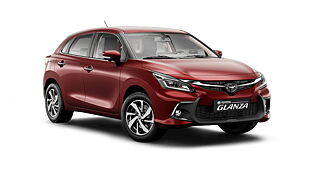

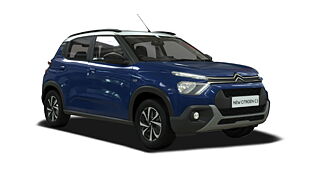

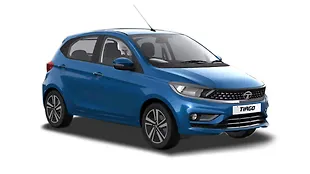
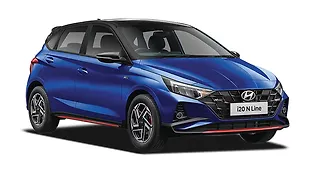
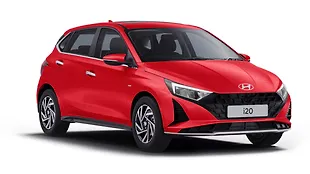
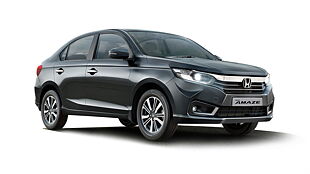
Explore Used Volkswagen Polo
Volkswagen Polo GT Reviews
- (61 Ratings) 21 Reviews
4.7/5
- Polo is my LovePolo is my love and everyone's love too such an amazing car we had in our garage, even though it was not with us this time I'm enjoying the moments that I had with it . It is our first car and the best one too , driving this car would be dream for every boys like me .The classy looks ,rough performance just like a pocket Dynamo . Maintaining this car is not that hard it's a good car.Rating parameters(out of 5)5
Exterior
4Comfort
5Performance
4Fuel Economy
5Value For Money
About the ReviewerPurchase UsedDriven forFew thousand kilometersRead MoreWas this review helpful?103 - Volkswagen Polo GT reviewIt's the best and i like it a lot except for its a 4 seater there is not much space for 5 people and there is no rear seats ac. If you have no problem with that then it's definitely the best car and absolutely value for money It also has all windows automatic up and down which is great and useful.Rating parameters(out of 5)5
Exterior
4Comfort
5Performance
4Fuel Economy
5Value For Money
About the ReviewerPurchase NewDriven forFew thousand kilometersRead MoreWas this review helpful?88 - Awesome carI bought my polo gt on feb'21. I'm very much satisfied with my car as I've driven 14000 km in 1 year. I got 20 km/l on highways and 12 km/l on city drive. Service they provide is also good.Rating parameters(out of 5)5
Exterior
3Comfort
5Performance
4Fuel Economy
5Value For Money
About the ReviewerPurchase NewDriven forFew thousand kilometersRead MoreWas this review helpful?1211


